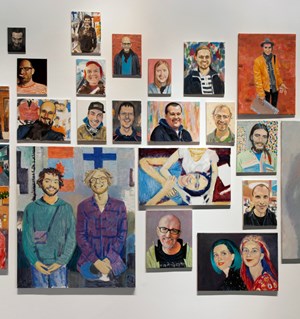
Whereas the early works of Russian artist Alexey Kallima stand out for their political overtones, his latest series (“Audience”) focuses on one simple and universal feature: the smile. The series, previously on show at Regina Gallery in Moscow, contained 65 portraits of smiling people. Kallima argues that the smile represents an emotion that is somehow missing in real life – through his work he therefore aims to draw the viewer into a form of involuntary therapy, resulting in the normalization of disturbed vital processes and a recovery towards a positive state.
Whereas the early works of Russian artist Alexey Kallima stand out for their political overtones, his latest series (“Audience”) focuses on one simple and universal feature: the smile. The series, previously on show at Regina Gallery in Moscow, contained 65 portraits of smiling people. Kallima argues that the smile represents an emotion that is somehow missing in real life – through his work he therefore aims to draw the viewer into a form of involuntary therapy, resulting in the normalization of disturbed vital processes and a recovery towards a positive state. Alexey Kallima graduated from the Fine Arts Department at the Krasnodar School of the Arts, his work appeared in the Venice Biennale in 1995 and 2009 and as special projects in the first, second, and fourth Moscow Biennale (2005, 2007, 2011), Kallima has also held solo exhibitions in Moscow, Europe, and the United States. In this interview Kallima briefed Artdependence Magazine about his work and future plans.
Artdependence Magazine: Tell us about your experience as a participant during the Venice Biennale’s of 1995 and 2009. What influence did this participation have on your artwork and career?
Alexey Kallima: It was a pleasure for me to be invited to both Venice Art Biennales. That was an interesting experience for me.
AD: You were born in Chechnya, and previously your work has referred to the Russia-Chechen conflict. Does your latest body of work also contain a political message and, if so, what is the message?
AK: At some point I consciously started to exclude the political from my projects. I tend to think that doing art without a straightforward political expression is my sort of policy.
AD: In one of the interviews you have mentioned: “In my youth I was deeply impressed by the frescoes in Santorini, where each person, whether he is selling fish or leaping over a bull, smiles a naïve smile. I think those people lived in happy times.” What about happiness in our times? Do you yourself feel happy?
AK: As for the smile, it appears as something that is missing; and this is the utopia of the project. It’s my wishful thinking.

Alexey Kallima "Audience" series. Installation view at Regina Gallery.

Alexey Kallima "Audience" series. Installation view at Regina Gallery.

Alexey Kallima "Audience" series. Installation view at Regina Gallery.

Alexey Kallima Portrait of EliKuka, 2015. Courtesy Regina Gallery.

Alexey Kallima Portrait of Valery Chtack, 2015. Courtesy Regina Gallery.
AD: You have tried and tested your own style within different genres: landscapes, portraits and even abstract painting. Are you searching for your own ultimate form of expression or does your foray into all these genres constitute a single plan or does it follow a single purpose?
AK: Yes, I am looking for the best form of expression. However, I do not put all my projects as beads on one string. My latest projects all have the common idea of recursion (describing the object with its own terms). The goal is the following: kung fu as an urge towards craftsmanship and plastic freedom.
AD: What are your future artistic plans? Do you have any new projects in mind that you can share with Artdependence Magazine?
AK: I have different plans for the future, but I would like to continue working with painting in oils. Thank you for the questions and attention.

Aleksey Kallima Untitled from the series EVERYTHING IS FOR SALE, 2012. Courtesy Regina Gallery.



AD: Good luck Alexey!

ArtDependence Magazine is an international magazine covering all spheres of contemporary art, as well as modern and classical art.
ArtDependence features the latest art news, highlighting interviews with today’s most influential artists, galleries, curators, collectors, fair directors and individuals at the axis of the arts.
The magazine also covers series of articles and reviews on critical art events, new publications and other foremost happenings in the art world.
If you would like to submit events or editorial content to ArtDependence Magazine, please feel free to reach the magazine via the contact page.